User's Guide
Operation Parts
(1)Status Information (2)Setting Button (3)Display Color Name
Button (4)Display Chromaticity Diagram Button (5)Simulation
Button (6)Save Image Button (7)Switch Camera/Photo Album
Button (8)Torch Button (9)Freeze
Button (10)Cursor (11)Color Name Pop-up (12)Mode
Tab (13)"Distinguish Color" Toolbar (14)Color Vision
Type Selector (15)Color Change Two-dimensional Slider
(16)"Distinguish Color" Mode Tab (17)Left Pop-up
Button (18)Zone Range Slider (19)Right Pop-up
Button (20)Preset Pop-up Menu
(21)"Find Color" Mode Tab (22)"Find Color"
Toolbar (23)Basic 11 Colors Ribbon (24)Left Pop-up
Button (25)Searching Radius Slider (26)Right Pop-up
Button (27)Basic 11 Colors Pop-up Menu (28)Chromaticity Diagram
(29)"Simulation" Mode Tab (30)Simulation
Toolbar (31)Simulation Color Vision Type Selector (32)Simulation
Intensity Slider (33)Image Source Pop-up Buttons
How to Use
This application has three modes for different purposes. You can switch the mode by using
the "Mode Tab" at the bottom of the "Main Screen."

- "Distinguish Color" mode

This mode is for distinguishing between difficult to distinguish colors.
- "Find Color" mode

This mode is for finding colors which are similar to a specified color on the screen
or by a color name.
- "Simulation" mode

This mode makes a simulation image according to a color vision type for showing it
to the person of type C (Common type). It may be helpful to understand the colors
which are hard to distinguish for various color vision types. Since a simulation
image is not necessarily exact, please use it as a rough indication.
Main Screen
All fundamental operations are performed in the "Main Screen."
The upper part has an information area. The right and left side in the upper half of the
screen have some operation buttons. The parts required for fundamental operation are located
in the lower part of the screen.
When a user does not touch the screen for 10 seconds or more, all texts and buttons except
"Cursor", "Color Name Pop-up", "Chromaticity Diagram", and
"Basic 11 Colors Ribbon" are made un-displayed. These are re-displayed by tapping
the screen.
Status Information

- (Upper left) Zone: Displays the range of a color zone as "Start Position~End
Position".
- (Center) Type: Displays the color vision type.
- (Upper right) Vary: Displays the color changing parameters in the color zone as
"Variation/Direction".
- (Center of the 2nd line) Zoom: Displays the magnification ratio in %.
Buttons
-
 Setting Button
Setting Button
Opens the "Settings Screen" for various settings.
-
 Display Color Name Button
Display Color Name Button
Displays the "Color Name Pop-up" for showing a color name at the position
of the cursor on the screen (Cursor color).
-
 Display Chromaticity Diagram Button
Display Chromaticity Diagram Button
Displays the "xy" or the "u'v'"
or the "u'v'" Chromaticity Diagram in the upper right screen.
Chromaticity Diagram in the upper right screen.
Only the range of sRGB in chromaticity diagrams are colored. The current color
changing method is also effective on the diagrams similar to the image on the
"Main Screen." This is convenient to grasp how and which range of color is
changed according to the value of the sliders and buttons.
-
 Simulation Button
Simulation Button
Displays a simulated image of each type of color vision. This button is used on
modes other than "Simulation" mode. A simulated image can be made from a
modified image in "Distinguish Color" mode and "Find Color" mode
in real-time. The value of the "Simulation Color Vision Type" and the
"Simulation Intensity" on the "Simulation" mode are used for
simulation.
-
 Save
Image Button
Save
Image Button
Saves a currently displayed image to a photo album after changing the color. It is
also possible to superimpose various kinds of parametric information on the image by
turning ON the "Save Image with Params" in the "Settings."
-
 Switch Camera/Photo Album Button
Switch Camera/Photo Album Button
Displays the "Imame Source Pop-up Buttons" to choose the source of the
image from "Rear Camera", "Front Camera" (only loading model) or
"Photo Album."
-
 Torch(Flashlight) Button
Torch(Flashlight) Button
Turns on a torch(flashlight). Appears only in a torch light loading model. Even if
this button is ON, it is turned OFF automatically when the application is operating
in the background, or while in the "Freeze" state by "Freeze
Button" or long press gesture. It becomes disabled when the image source is
"Photo Album."
-
 Freeze Button
Freeze Button
Stops a video capture and displays a still image ("Freeze" state). Nothing
changes when the image source is a "Photo Album." It is possible to scroll
an image with the pan gesture in the "Freeze" state. Please use it in
combination with image scaling by using the pinch gesture. Changing the color,
displaying the color name, and moving the cursor are also possible in the
"Freeze" state.
-
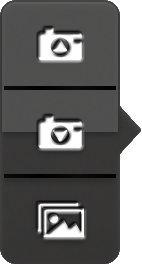 Image
Source Pop-up Buttons
Image
Source Pop-up Buttons
Chooses the source of the image from " Rear Camera", "
Rear Camera", " Front Camera" (only loading model) or "
Front Camera" (only loading model) or " Photo Album."
Photo Album."
Cursor

The round mark used in order to specify the position on the screen. It is displayed when
the "Find Color" mode or the "Display Color Name Button" is set to
ON. The cursor keeps the color of the portion of an image and is called the "Cursor
Color." It can be moved by tapping.
Color Name Pop-up
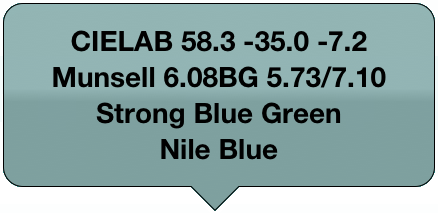
Displays 4 lines describing the "Cursor Color" information which is specified
by the "Color Information" in the "Settings." It shows
"CIELAB", "Munsell (approximate value)", "JIS(Japanese
Industrial Standards) Generic Color Name" and "JIS Common Color Name
(nearest)" by default.
The weighted average of 5x5 pixels in every direction calculated by Gaussian filter is
used for deciding the color at the cursor position.
The color value or name displayed here is not necessarily exact, although it is
calculated based on several standards under the assumption of using sRGB color space and
D65 light sources.
Mode Tab

Switches between the "Distinguish Color" Mode, the "Find Color"
Mode, and the "Simulation" Mode.
"Distinguish Color" Mode
This mode is used by persons of P, D, or T color vision type in order to distinguish
between difficult to distinguish colors. This application sets up a color zone which can
divide confusing colors, and change them to a color which is more easily distinguishable
while maintaining the original color as much as possible.
A division of the color zone and the color to be changed are calculated in the uniform
color space in accordance with human feeling.
In order for the color changed image to be easy to understand, it will be displayed on
the screen alternately with the original image. To the observer, it will appear to be
blinking.
- "Distinguish Color" Toolbar

"Left Pop-up Button", "Zone Range Slider", "Right Pop-up
Button"
- Left Pop-up Button

Displays "Preset Pop-up Menu."
- Zone Range Slider (possible value: (0.0~1.0)~(0.0~1.0))

A slider which specifies the range of a color zone in which the colors are changed.
It has two thumb(knob) controls on the right and left. The leftmost (value 0.0) area
contains green, and the rightmost (value 1.0) area contains red (it is called the
zone coordinate).
The zone coordinate of the starting position of a color zone is set up by the left
thumb, and the zone coordinate of the end position is set by the right thumb. If the
area near the center of both thumbs (blue portion) is touched, the whole can be
moved simultaneously.
The color of the slider is also reversed when the "Reverse Color Zone" is
ON in the "Settings." When the "Auto Color Zone" is ON in the
"Setup", it becomes yellow between the thumbs. According to the color
vision type in the "Settings," the color zone is forms the best shape
where the person tends to distinguish color. You can check which color actually
changes by the range of the color zone. You can show a chromaticity diagram by
pressing the "Display Chromaticity Diagram Button."
- Right Pop-up Button

Turns ON and OFF the display of the "Color Vision Type Selector" and the
"Color Change Two-dimensional Slider (Distinguish Color)."
- Preset Pop-up Menu

A pop-up menu for selecting a preset. There are 8 presets named Preset 1~8, which
can store a set of parameters used in the "Distinguish Color" Mode. When a
preset name on the preset menu is tapped, the preset is selected and parameters are
loaded and reflected immediately.
Moreover, when a long press gesture in 2 seconds or more is performed on a preset
name, current parameters in use can be overwritten to the selected preset. Although
each preset has an initial value, the user can rewrite all the presets freely.
- Color Vision Type Selector

A selector which specifies a color vision type of a user."P" means Protan,
"D" means Deutan and "T" means Tritan. A color vision type can
be also set in the "Settings" and "Find Color" Mode, and these
are interlocking.
- Color Change Two-dimentional Slider (Distinguish Color) (possible value:
Variation (distance) 0.0〜0.5, Direction (angle) 0.0〜1.0)

A two-dimensional slider which specifies how the color belonging to a color zone is
changed. The color modification values when this slider is moved are different
according to the color vision type. The slider is circular.
There are two kinds of parameters for color changing. One is the "Variation
(distance) (of a color change)", and the other is the "Direction (angle)
(of a color change)." Both values are 0.0 when the thumb is located in the
center of the circle.
The "Variation (distance) (of a color change)" parameter is the distance
between the center of the circle and the thumb when the diameter of the circle is
1.0, and the variation of color change becomes larger as the value is
increased.
The "Direction (angle) (of a color change)" parameter is calculated from
the angle of the thumbs position in a clockwise rotation when the upper part of a
circle is 0.0 and dividing it by 360 degrees (2 pi) and is normalized in the 0.0 to
1.0 section. For example, in the case of P and D types, it will change to white when
the value is 0.0 (above), and yellowish when the value is 0.25 (right), dark when
the value is 0.5 (below), and bluish when the value is 0.75 (left).
"Boost mode" is changed to ON when this slider is double-tapped. (The
slider background becomes a deep color and the color of the thumb-slider changes to
golden.)
"Find Color" Mode
In this mode, the color approximated as the "Cursor Color" (color currently
displayed on the cursor) is changed. This mode is used in order to find the similar
color of the part of the displayed image or to find one of the basic colors set up
beforehand.
The word of "similar color" in this mode differs in nuance from how the term
is generally used. For example, although bright yellow and dark yellow are not generally
similar colors, they are regarded as similar colors in this application. This
application judges whether a color is similar or not with chromaticity (sometimes called
"tone" etc.), without taking into consideration the difference in brightness
(bright or dark).
- "Find Color" Toolbar

Displays the "Left Pop-up Button", the "Searching Radius Slider"
and the "Right Pop-up Button."
- Basic 11 Colors Ribbon

The domain which horizontally arranges the basic 11 colors used as the reference to
find a color, and has a form like an oblong ribbon. Colors are displayed
sequentially from the left Achromatic(N), Red(R), Yellow Red (YR), Yellow(Y), Green
Yellow(GY), Green(G), Blue Green(BG), Blue(B), Purple Blue(PB), Purple(P) and Red
Purple(RP), and selected form vivid colors in the JIS Generic Color Name
standard.
While this domain is displayed on the main screen, you can set the "Cursor
Color" to the ribbon color by aligning the cursor position with a part of the
ribbon for using as the searching color. When one of the color names is chosen from
the "Basic 11 Colors Pop-up Menu", the cursor moves onto this ribbon
automatically.
- Left Pop-up Button

Displays the "Basic 11 Colors Pop-up Menu."
- Searching Radius Slider (possible value: 0.0〜1.0)

Specifies the searching radius for how similar a color with a searching color
(cursor color). If this value is small, only similar colors will be looked for, and
if the value is large, also a color which is not so similar will also be looked
for.
The color judged to be similar is changed according to parameters set with the
"Color Change Two-dimensional Slider." The calculation of a distance
between colors uses u'v' chromaticity according to the distance on u'v' coordinates.
The value 1.0 of a searching radius is equivalent to the value 0.1 in u'v'
coordinates.
- Right Pop-up Button

Displays the "Color Vision Type Selector" and the "Color Change
Two-dimensional Slider (Find Color)."
- Basic 11 Colors Pop-up Menu
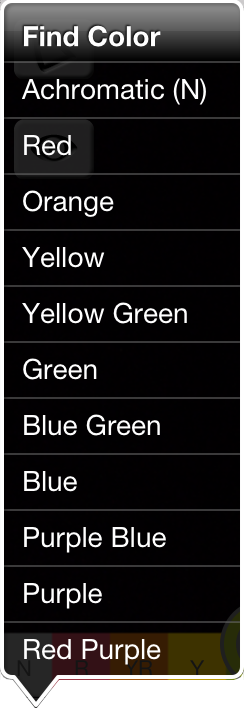
A pop-up menu for selecting a basic color as a reference to find color. When one of
the color names is chosen by tapping, the cursor moves onto the same color part of
the "Basic 11 Colors Ribbon" automatically.
- Color Vision Type Selector

A selector which sets up the color vision type of a user. "P" means
Protan, "D" means Deutan and "T" means Tritan. The color vision
type can be also set in the "Settings" and "Distinguish Color"
mode, and these are interlocking.
- Color Change Two-dimensional Slider (Find Color) (possible value: Variation
(distance) 0.0〜0.5, Direction (angle) 0.0〜1.0)

A two-dimensional slider which sets up how similar colors are changed. The meaning
and operation are the same as the "Color Change Two-dimensional Slider
(Distinguish Color) in the "Distinguish Color" mode. However, the value is
independent. The "Boost mode" does not exist in the "Find Color"
mode."
"Simulation" Mode
Creates an image which persons of a specified color vision type are probably seeing from
the original image source, and displays it.
Although the simulated image is made with the same technology as the "Chromatic
Vision Simulator", which is a sister application, it is not necessarily exact.
Please use this simulation image as a rough indication of what the specified color
vision type might be seeing.
- Simulation Toolbar

Displays the "Simulation Color Vision Type Selector" and the
"Simulation Intensity Slider."
- Simulation Color Vision Type Selector

Sets up a color vision type of the color vision simulation performed in this mode
and when the "Simulation Button" are turned ON. "C" means Common
type, "P" means Protan type, "D" means Deutan type and
"T" means Tritan type. The original image is displayed when "C"
type is chosen.
- Simulation Intensity Slider (possible value: 0.0〜1.0)

Specifies an intensity of the color vision simulation performed in this mode and
when the "Simulation Button" is turned ON.
When the value is 0.0, the original image is displayed, but when the value is 1.0, a
full simulated image is displayed. When the value is in between, an image of linear
interpolation according to the value of the original and the simulation is created
and displayed.
Settings Screen
Performs various settings.
- Color Vision Type
Choose a color vision type used in "Distinguish Color" and "Find
Color" mode from "Protan", "Deutan" and "Tritan."
- Color Changing Option Settings
Sets up various color changing options used in the "Distinguish Color"
mode.
- Auto Color Zone
Moves the center of the color zone to a position of the "Cursor Color"
automatically for making it easy to distinguish a "Cursor Color." When
this is ON, the "Color Zone Range Slider" becomes yellow and it moves
automatically. Please adjust the width of the color zone with the "Color
Zone Range Slider" as usual.
- Reverse Color Zone
Reverses a color zone. For example, when the range of the "Color Zone Range
Slider" is 0.3~0.5, then 0.0~0.3 and 0.5~1.0 they become color zones, and
the color of the range is changed. This setting is effective to distinguish both
sides of red and green at once (P, D type example).
When it is ON, the "R" indicator appears at the end of the
"Zone" in the "Status Information."
- Inversion (of a color change) on Both Sides (of the zone
coordinate)
This setting is an optional feature for distinguishing the red and green side
quickly in the case of P and D types, and green and blue sides quickly in the
case of T types.
The "Direction (angle) (of a color change)" of the "Color Change
Two-dimensional Slider" is used as a 180 degree (pi) = 0.5 rotated value
when a zone coordinate of the color is smaller than the achromatic (monochrome)
position (the left-hand side of the "Color Change Two-dimensional Slider
(Find Color)).
On a chromaticity diagram, only the color which belongs to the green side from
the line, that connected with yellow, white and blue, is changed with the
"Direction (angle) (of a color change)" of 0.5 (blackish) when it is
0.0 (whitish), 0.75 (bluish) when it is 0.25 (yellowish).
- Keep Achromatic Zone
This switch makes neither white nor gray changes in a color, and keeps them from
blinking. Correctly, the color, which has a short distance (less than +-0.05)
from the achromatic on the zone coordinate, is not changed. Yellow and Blue in
the case of P, D types and Red and Blue Green in the case of T types are also
not changed.
- Boost Mode
This is the mode which makes the color change stronger than usual. Colors are
changed sharply according to the "Variation (distance) (of a color
change)" of the "Color Change Two-dimensional Slider (Distinguish
Color)."
When it is ON, the background color of the "Color Change Two-dimensional
Slider (Distinguish Color)" turns into a deep color, and the color of the
thumb-slider also changes from silver to gold, and the "B" indicator
appears at the "Vary" in the "Status Information."
This switch can be turned ON and OFF by double-tapping on the "Color Change
Two-dimensional Slider (Distinguish Color)."
The color changing algorithm in this mode is different from the one usually
used. It does not use the method with the confusion line as usual, but uses the
method which makes the color close to the color of the spectrum light 575 nm and
475 nm for P and D types, 575 nm and 475 nm for T types.
- User Interface Settings
Performs various settings related to the user interface.
- Big Buttons
Big Text and Buttons are used. (default value: OFF on iPhone, ON on iPad)
- Tap Sound
Enable tapping sound when buttons are tapped.
- Freeze on Long Press
Freeze image by pressing the main screen 1 second or more in addition to pushing
the "Freeze Button."
- Save Img with Vol. Btn
Save the screen by pushing the "Volume" button in addition to pushing
the "Save Button."
- Save Superimposed Img
Superimpose a mode name and parameters in a saved image to the photo album.
- Chromaticity Diagram
Choose the kind of chromaticity diagram which is displayed with the
"Chromaticity Button. You can choose it from the "xy chromaticity
diagram"(CIE1931) or the "u'v' chromaticity diagram"(CIE1976).
- Color Information
Choose kinds of color in for mar ion that are displayed on each line of the
"Color Name Pop-up."
Please choose them from "RGB (original value)", "XYZ" (CIE
1931), "xyY" (CIE 1931), "CIELAB" (CIE 1976),
"CIELUV" (CIE 1976), "Munsell (approximate value), "JIS
Generic Color Name" (JIS Z8102) , "JIS Common Color Name
(nearest)" (JIS Z8102) and "None."
- Preset Settings
Push the Preset 1~8 to display and set the parameters in each preset.
Initial values are already set in the presets in the initial state. Please see the
"Preset Initial Settings" for details.
- Preset Name
Gives an alias name to the preset. This alias name is displayed in the
"Preset Pop-up Menu" in the "Distinguish Color" mode. It is
convenient to attach short and intelligible names, such as "Brighten
Red"
- Parameters
Sets parameters used on the "Distinguish Color" mode. The meaning and
setting range of each parameter are the same as switches and sliders in the main
screen.
- Color Zone Start
- Color Zone End
- Variation (distance) (of a color change)
- Direction (angle) (of a color change)
- Auto Color Zone
- Reverse Color Zone
- Inversion on Both Sides (of the zone coordinate)
- Keep Achromatic Zone
- Boost Mode
- Use This Preset Immediately
Use these parameters in this preset as the current parameters immediately.
Current parameters are overwritten and lost.
- Save Current Parameters Here
Save the parameters currently in use to this preset. The parameters
currently saved in this preset will be overwritten and lost.
- Reset Parameters to Default
All the parameters in this preset are returned to default values according
to the "Color Vision Type" currently selected.
- Reset
Resets all parameters in the "Settings" (except the "Color Vision
Type") and returns them to the default value.
In this application, a color or a range of color, which is appointed the same
parameter value, is different if a different color vision type is specified. Presets
for P, D types are set up in the normal condition. If you would like to use preset
for T types, please push this button and reset the parameters after choosing
"Tritan" in the "Color Vision Type." Japanese(English) preset
names can be changed into English(Japanese) names in the same way.
- Display Manual
Push to display this manual.
- Application Information
The version and copyright information are displayed.
Supported Gesture List
This application supports some gestures.
- Single Tap
The camera focus and exposure are adjusted to a tapping position when the camera is
chosen as the image source and the cursor is not displayed.
Moves the cursor to a tapping position when it is displayed.
Displays the user interface when it is undisplayed.
- Double Tap
Resets zoom to 100%, and pan to 0, when the cursor is not displayed.
When the "Color Change Two-dimensional Slider (Distinguish Color)" is
double tapped, the "Boost Mode" is turned ON and OFF.
When the "Zone Range Slider" or the "Searching Radius Slider" is
double tapped, the zone width or the searching radius is set to 0.0, the original
image is displayed. To return to the previous value, double tap again.
- Pinch
An image is expanded and reduced. The maximum zoom magnification is 500%.
- Pan
Pans (scrolls) an image when in "Freeze" state or the image source is
"Photo Album."
- Shake
Resets zoom to 100%, and pan to 0, and release "Freeze" if in
"Freeze" state.
- Long Press
One second: "Freeze" if not in "Freeze" state, 2 seconds:
Release "Freeze" if in "Freeze" state.
- Swipe Right with 2 Fingers
Undisplays the user interface. They can be re-displayed by single tapping.
Preset Initial Settings
for P, D types
|
Preset 1 |
| Preset
Name: "Brighten Red" |
| Color Zone
Start: 0.8 |
Color Zone End: 1.0
|
| Variation (distance):
0.2 |
Direction (angle): 0.0
|
| Auto Color Zone: OFF
|
Reverse Color Zone:
OFF |
| Inversion on Both
Sides: ON |
Keep Achromatic Zone:
ON |
| Boost
Mode: OFF |
|
Preset 2 |
| Preset
Name: "Darken Green" |
| Color Zone
Start: 0.0 |
Color Zone End: 0.25
|
| Variation (distance):
0.2 |
Direction (angle): 0.0
|
| Auto Color Zone: OFF
|
Reverse Color Zone:
OFF |
| Inversion on Both
Sides: ON |
Keep Achromatic Zone:
ON |
| Boost
Mode: OFF |
|
Preset 3 |
| Preset
Name: "Brighten Red / Darken Green" |
| Color Zone
Start: 0.25 |
Color Zone End: 0.8
|
| Variation (distance):
0.2 |
Direction (angle): 0.0
|
| Auto Color Zone: OFF
|
Reverse Color Zone: ON
|
| Inversion on Both
Sides: ON |
Keep Achromatic Zone:
ON |
| Boost
Mode: OFF |
|
Preset 4 |
| Preset
Name: "Dist. Orange and YellowGreen" |
| Color Zone
Start: 0.33522 |
Color Zone End:
0.48522 |
| Variation (distance):
0.45 |
Direction (angle): 0.2
|
| Auto Color Zone: OFF
|
Reverse Color Zone: ON
|
| Inversion on Both
Sides: ON |
Keep Achromatic Zone:
OFF |
| Boost
Mode: OFF |
|
Preset 5 |
| Preset
Name: "Auto Color Zone / 0.2 / Bright" |
| Color Zone
Start: 0.0 |
Color Zone End: 0.2
|
| Variation (distance):
0.2 |
Direction (angle): 0.0
|
| Auto Color Zone: ON
|
Reverse Color Zone:
OFF |
| Inversion on Both
Sides: OFF |
Keep Achromatic Zone:
ON |
| Boost
Mode: OFF |
|
Preset 6 |
| Preset
Name: "Yellow WarmCol./ Blue ColdCol." |
| Color Zone
Start: 0.0 |
Color Zone End: 1.0
|
| Variation (distance):
0.4 |
Direction (angle):
0.25 |
| Auto Color Zone: OFF
|
Reverse Color Zone:
OFF |
| Inversion on Both
Sides: ON |
Keep Achromatic Zone:
ON |
| Boost
Mode: ON |
|
Preset 7 |
| Preset
Name: Blue Cold Colors |
| Color Zone
Start: 0.0 |
Color Zone End:
0.33522 |
| Variation (distance):
0.25 |
Direction (angle):
0.75 |
| Auto Color Zone: OFF
|
Reverse Color Zone:
OFF |
| Inversion on Both
Sides: OFF |
Keep Achromatic Zone:
OFF |
| Boost
Mode: ON |
|
Preset 8 |
| Preset
Name: "No Change" |
| Color Zone
Start: 0.5 |
Color Zone End: 0.5
|
| Variation (distance):
0.0 |
Direction (angle): 0.0
|
| Auto Color Zone: OFF
|
Reverse Color Zone:
OFF |
| Inversion on Both
Sides: OFF |
Keep Achromatic Zone:
OFF |
| Boost
Mode: OFF |
for T types
|
Preset 1 |
| Preset
Name: "Brighten Green" |
| Color Zone
Start: 0.8 |
Color Zone End: 1.0
|
| Variation (distance):
0.2 |
Direction (angle): 0.0
|
| Auto Color Zone: OFF
|
Reverse Color Zone:
OFF |
| Inversion on Both
Sides: ON |
Keep Achromatic Zone:
ON |
| Boost
Mode: OFF |
|
Preset 2 |
| Preset
Name: "Darken Blue" |
| Color Zone
Start: 0.0 |
Color Zone End: 0.25
|
| Variation (distance):
0.2 |
Direction (angle): 0.0
|
| Auto Color Zone: OFF
|
Reverse Color Zone:
OFF |
| Inversion on Both
Sides: ON |
Keep Achromatic Zone:
ON |
| Boost
Mode: OFF |
|
Preset 3 |
| Preset
Name: "Brighten Green / Darken Blue" |
| Color Zone
Start: 0.25 |
Color Zone End: 0.8
|
| Variation (distance):
0.2 |
Direction (angle): 0.0
|
| Auto Color Zone: OFF
|
Reverse Color Zone: ON
|
| Inversion on Both
Sides: ON |
Keep Achromatic Zone:
ON |
| Boost
Mode: OFF |
|
Preset 4 |
| Preset
Name: "Dist. Green and PurpleGreen" |
| Color Zone
Start: 0.63022 |
Color Zone End:
0.78022 |
| Variation (distance):
0.45 |
Direction (angle): 0.2
|
| Auto Color Zone: OFF
|
Reverse Color Zone: ON
|
| Inversion on Both
Sides: ON |
Keep Achromatic Zone:
OFF |
| Boost
Mode: OFF |
|
Preset 5 |
| Preset
Name: "Auto Color Zone / 0.2 / Bright" |
| Color Zone
Start: 0.0 |
Color Zone End: 0.2
|
| Variation (distance):
0.2 |
Direction (angle): 0.0
|
| Auto Color Zone: ON
|
Reverse Color Zone:
OFF |
| Inversion on Both
Sides: OFF |
Keep Achromatic Zone:
ON |
| Boost
Mode: OFF |
|
Preset 6 |
| Preset
Name: "Redden Green / BlueGreen Blue" |
| Color Zone
Start: 0.0 |
Color Zone End: 1.0
|
| Variation (distance):
0.4 |
Direction (angle):
0.25 |
| Auto Color Zone: OFF
|
Reverse Color Zone:
OFF |
| Inversion on Both
Sides: ON |
Keep Achromatic Zone:
ON |
| Boost
Mode: ON |
|
Preset 7 |
| Preset
Name: Redden B, BP, P, RP |
| Color Zone
Start: 0.0 |
Color Zone End:
0.63022 |
| Variation (distance):
0.25 |
Direction (angle):
0.75 |
| Auto Color Zone: OFF
|
Reverse Color Zone:
OFF |
| Inversion on Both
Sides: OFF |
Keep Achromatic Zone:
OFF |
| Boost
Mode: ON |
|
Preset 8 |
| Preset
Name: "No Change" |
| Color Zone
Start: 0.5 |
Color Zone End: 0.5
|
| Variation (distance):
0.0 |
Direction (angle): 0.0
|
| Auto Color Zone: OFF
|
Reverse Color Zone:
OFF |
| Inversion on Both
Sides: OFF |
Keep Achromatic Zone:
OFF |
| Boost
Mode: OFF |
Notes
- This application software was developed by Kazunori Asada (Ph.D. of Medical Science
and Ph.D. of Media design), and is released free. (patent pending)
- The simulation algorithm which is used in this application is based on the proposed
method of the following treatise, and reproduces the color in which a dichromat,
which is the biggest grade of color vision deficiency in each type of color vision,
is probably seen by high-speed operation artificially.
H. Brettel, F.Viénot, and J. D. Mollon: Computerized simulation of color
appearance for dichromats, Journal of the Optical Society of America A, vol.14,
no.10, pp.2647-2655 (Oct. 1997).
- The simulation image displayed in this application is made by prediction under how
dichromats see the color under a specific technique and conditions, and is not
necessarily exact. Moreover, each individual has different color vision.
- The color value and name displayed in this application is computed by calculation
based on several standards under the specific precondition, and is not necessarily
exact. Moreover, there are variations in the characteristics of the screen and
camera on the device to be used.
- The color name searching algorithm currently used with this application, is
developed in collaboration with Mr. Daisuke Nishioka who is a developer of the
"Chromatic Color Helper."
- "Color Vision Deficiency", "Protanope / Protanomal / Protan",
"Deuteranope / Deuteranomal / Deutan" and "Tritanope / Tritanomal /
Tritan" used in this manual are scientific terms.
- ACVRangeSelector, Copyright © 2013 Antonio Cabezuelo Vivo (MIT license).
- CMPopTipView, Copyright © 2010-2012 Chris Miles (MIT license).
- InAppSettingsKit, Copyright © Luc Vandal and Ortwin Gentz (BSD license).
- LKPopupMenuController, Copyright © 2011 Hiroshi Hashiguchi (MIT license).
- QBPopupMenu, Copyright © 2013 by Katsuma Tanaka (MIT License).
- RMUniversalAlert, Copyright © 2014 Ryan Maxwell (MIT License).
- URBSegmentedControl, Copyright © 2012 Nicholas Shipes, Urban10 Interactive and other
contributors (MIT license).
- TabBarKit, Copyright © 2010-2011 David Morford (BSD license).
- BSD license: (InAppSettingsKit, TabBarKit)
Redistribution and use in source and binary forms, with or without modification, are
permitted provided that the following conditions are met:
* Redistributions of source code must retain the above copyright notice, this list
of conditions and the following disclaimer.
* Redistributions in binary form must reproduce the above copyright notice, this
list of conditions and the following disclaimer in the documentation and/or other
materials provided with the distribution.
* Neither the name of the author nor the names of its contributors may be used
to endorse or promote products derived from this software without specific prior
written permission.
THIS SOFTWARE IS PROVIDED BY THE COPYRIGHT HOLDERS AND CONTRIBUTORS "AS IS" AND ANY
EXPRESS OR IMPLIED WARRANTIES, INCLUDING, BUT NOT LIMITED TO, THE IMPLIED WARRANTIES
OF MERCHANTABILITY AND FITNESS FOR A PARTICULAR PURPOSE ARE DISCLAIMED. IN NO EVENT
SHALL THE COPYRIGHT OWNER OR CONTRIBUTORS BE LIABLE FOR ANY DIRECT, INDIRECT,
INCIDENTAL, SPECIAL, EXEMPLARY, OR CONSEQUENTIAL DAMAGES (INCLUDING, BUT NOT LIMITED
TO, PROCUREMENT OF SUBSTITUTE GOODS OR SERVICES; LOSS OF USE, DATA, OR PROFITS; OR
BUSINESS INTERRUPTION) HOWEVER CAUSED AND ON ANY THEORY OF LIABILITY, WHETHER IN
CONTRACT, STRICT LIABILITY, OR TORT (INCLUDING NEGLIGENCE OR OTHERWISE) ARISING IN
ANY WAY OUT OF THE USE OF THIS SOFTWARE, EVEN IF ADVISED OF THE POSSIBILITY OF SUCH
DAMAGE.
- MIT license: (ACVRangeSelector, CMPopTipView, LKPopupMenuController, QBPopupMenu,
RMUniversalAlert and URBSegmentedControl)
Permission is hereby granted, free of charge, to any person obtaining a copy of this
software and associated documentation files (the "Software"), to deal in
the Software without restriction, including without limitation the rights to use,
copy, modify, merge, publish, distribute, sublicense, and/or sell copies of the
Software, and to permit persons to whom the Software is furnished to do so, subject
to the following conditions:
The above copyright notice and this permission notice shall be included in all
copies or substantial portions of the Software.
THE SOFTWARE IS PROVIDED "AS IS", WITHOUT WARRANTY OF ANY KIND, EXPRESS OR
IMPLIED, INCLUDING BUT NOT LIMITED TO THE WARRANTIES OF MERCHANTABILITY, FITNESS FOR
A PARTICULAR PURPOSE AND NONINFRINGEMENT. IN NO EVENT SHALL THE AUTHORS OR COPYRIGHT
HOLDERS BE LIABLE FOR ANY CLAIM, DAMAGES OR OTHER LIABILITY, WHETHER IN AN ACTION OF
CONTRACT, TORT OR OTHERWISE, ARISING FROM, OUT OF OR IN CONNECTION WITH THE SOFTWARE
OR THE USE OR OTHER DEALINGS IN THE SOFTWARE.





 Setting Button
Setting Button Display Color Name Button
Display Color Name Button Display Chromaticity Diagram Button
Display Chromaticity Diagram Button or the "u'v'"
or the "u'v'" Chromaticity Diagram in the upper right screen.
Chromaticity Diagram in the upper right screen. Simulation Button
Simulation Button Save
Image Button
Save
Image Button Switch Camera/Photo Album Button
Switch Camera/Photo Album Button  Torch(Flashlight) Button
Torch(Flashlight) Button Freeze Button
Freeze Button Image
Source Pop-up Buttons
Image
Source Pop-up Buttons Rear Camera", "
Rear Camera", " Front Camera" (only loading model) or "
Front Camera" (only loading model) or " Photo Album."
Photo Album."



















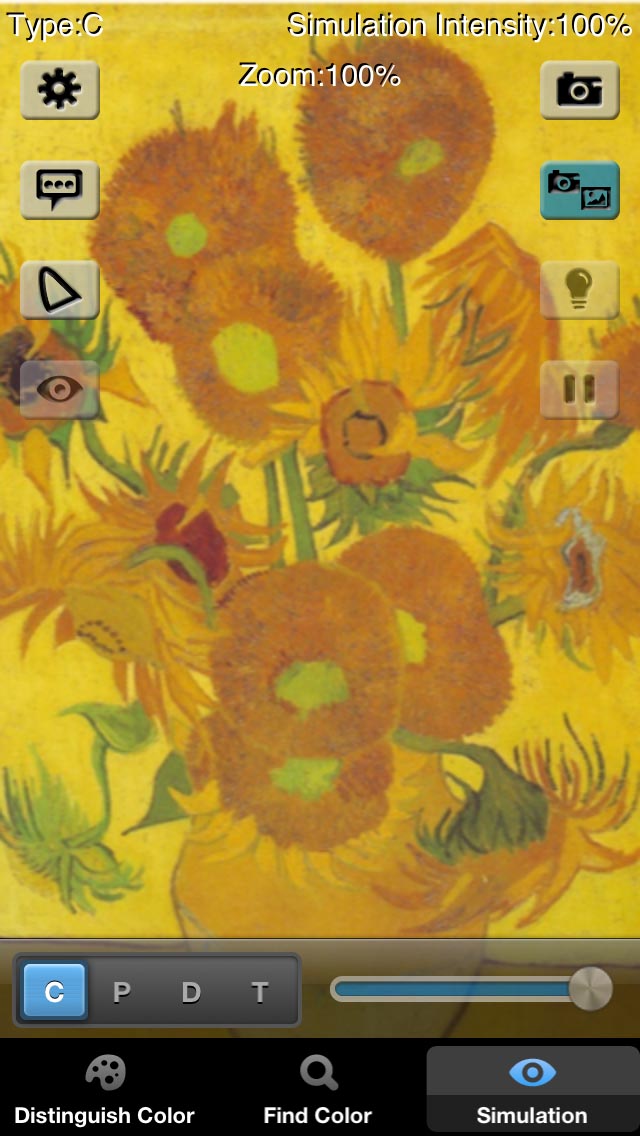

 open image
open image open image
open image open image
open image open image
open image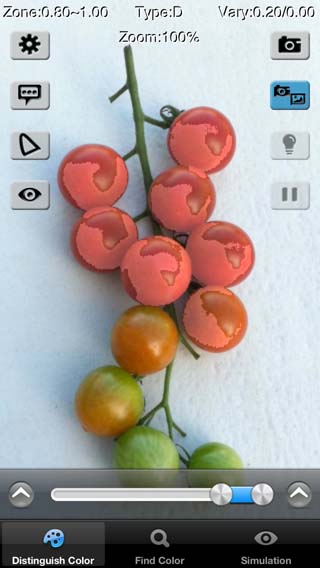 open image
open image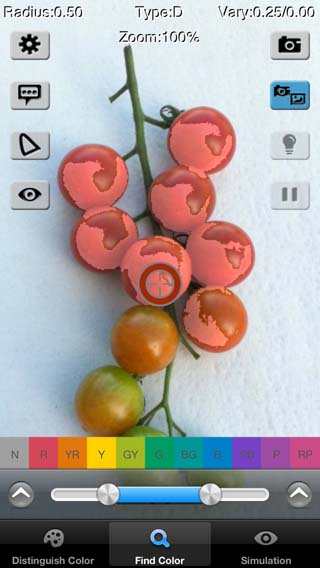 open image
open image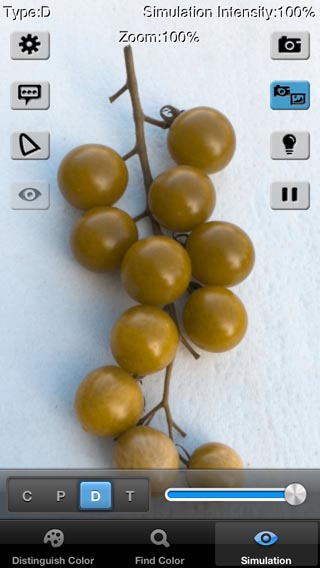 open image
open image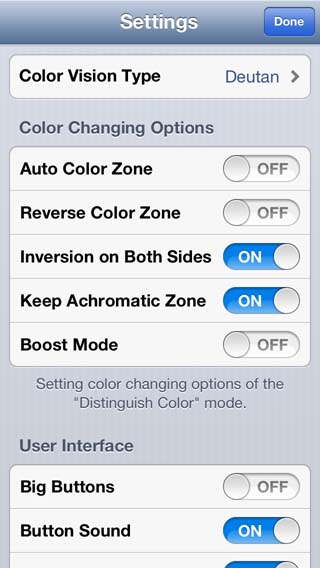 open image
open image open image
open image